Back to blog
6 MIN READ
How to Find Bugs in Mobile Applications
PUBLISHED
16 January, 2025

Product Analytics Expert
How can you optimize your bug-hunting process?
It's every app developer's nightmare—an elusive bug causing chaos in your mobile application. In fact, it's estimated that software bugs cost the US economy around $2.5 trillion each year! That’s why we’ve made this foolproof guide to help you find any bugs and fix them efficiently.
This UXCam guide will walk you through everything you need to know about identifying and resolving bugs in mobile applications, regardless of your experience level.
Why listen to us?
At UXCam, we’ve supported over 37,000 clients worldwide, including Costa Coffee, PlaceMakers, and JobNimbus.
Our work has led to significant improvements, such as Costa Coffee increasing app registrations by 15% and PlaceMakers doubling their sales. JobNimbus, meanwhile, doubled their app store rating and improved adoption rates by 25% in just four weeks.
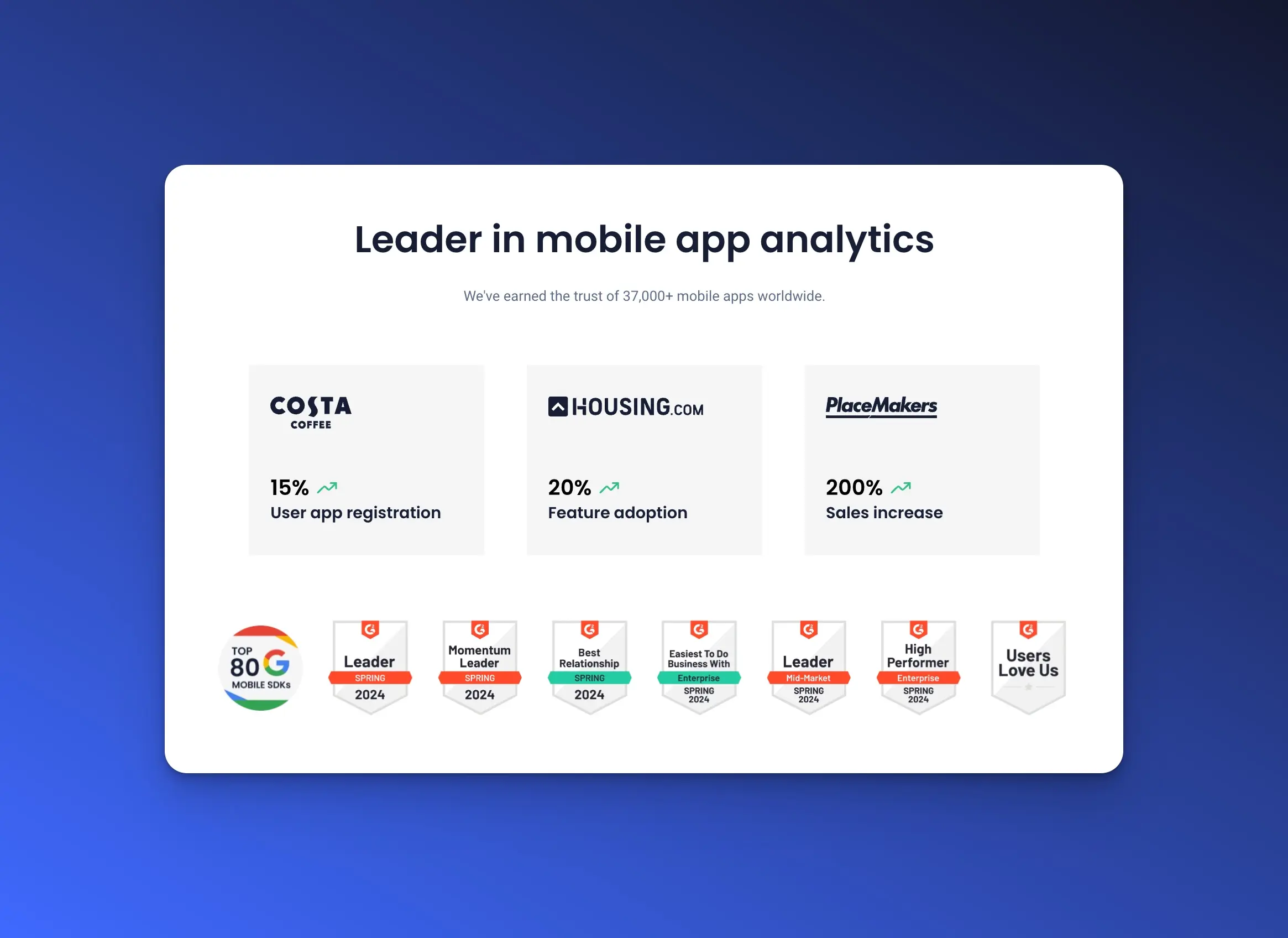
These achievements showcase our ability to identify critical pain points, improve app functionality, and drive better business outcomes for our clients.
Summary - How to find bugs in mobile applications
| Steps | Description |
|---|---|
| Use a mobile analytics tool | Use session recordings, heatmaps, and crash reports to spot trouble areas and prioritize fixes. |
| Manual testing | Physically test functionalities thoroughly on diverse devices, focusing on usability and real-world interactions. |
| Automated testing | Automate unit, integration, and UI tests to quickly identify visual or functional defects. |
| Beta testing | Release an app version to a small group, gather diverse feedback, and compare feature variations. |
| Analyze user feedback | Monitor app reviews, social media, in-app reports, and analytics to discover, prioritize, and address issues. |
| Continuous monitoring | Integrate real-time alerts, limit notification frequency, and share relevant session replays to expedite resolutions. |
What are bugs in mobile applications?
A bug is an error or flaw in a software application that causes it to produce an unexpected result or behave in unintended ways. These can range from minor glitches to significant issues that affect the functionality of an app. Common types of bugs include crashes, UI freezes, and unhandled exceptions.
Using mobile app analytics tools like UXCam can help you find bugs more efficiently. One of the standout features of our platform is the crash log session tagging. This allows users to mark sessions where crashes occur as "favorite sessions." Teams can then easily track and investigate these issues later, focusing on sessions that share similar problems.
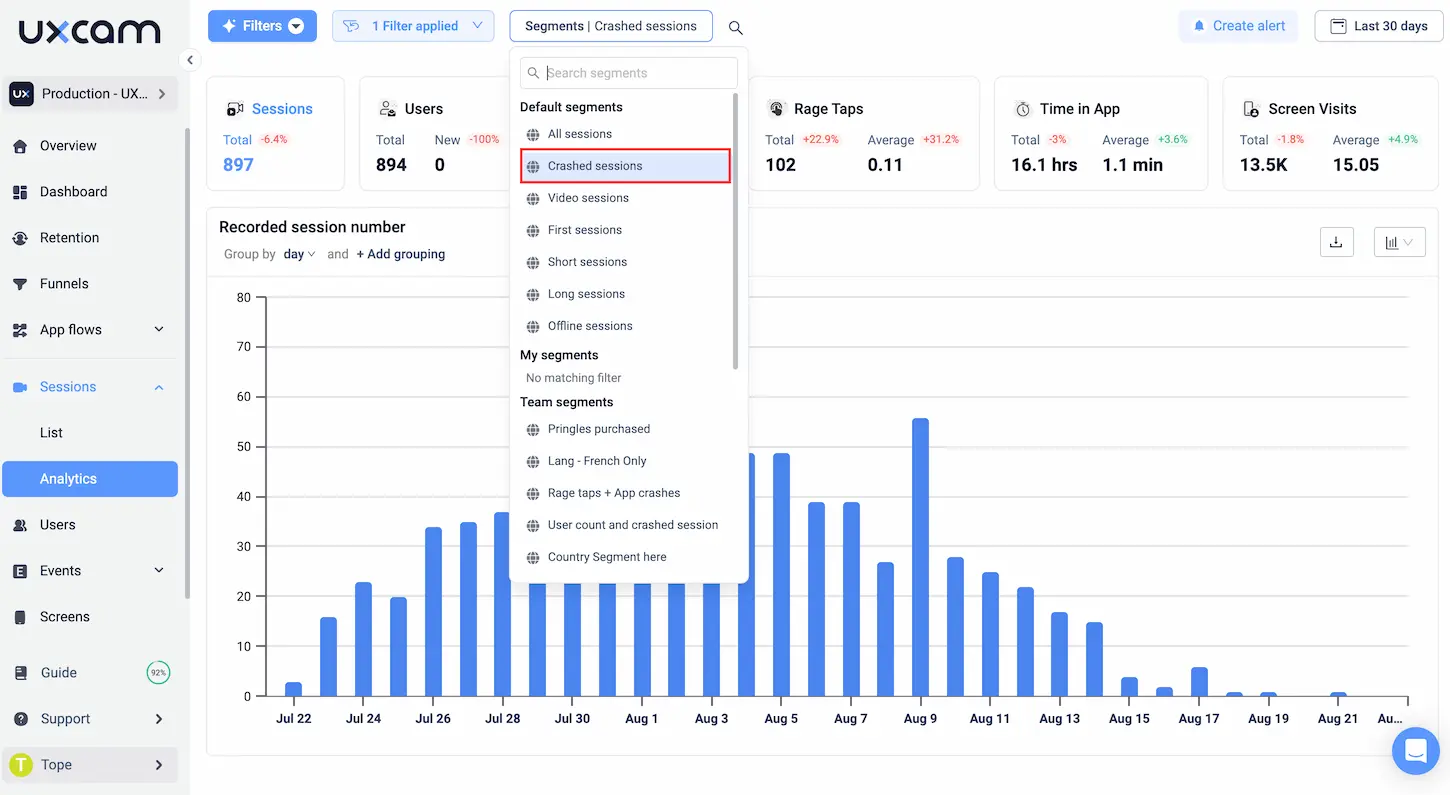
This feature not only streamlines the debugging process but also facilitates collaboration among team members, as they can refer back to these tagged sessions for further analysis.
Why finding bugs in mobile apps is important
1. User experience and retention
Bugs can cause crashes, slow performance, and unexpected behavior, leading to user frustration. In fact, around 40% of US-based mobile users will uninstall an app with too many software issues and switch to a competitor that offers a bug-free experience.
2. Security and privacy
Bugs can be exploited to compromise the security and privacy of users, a growing concern as evidenced by over 26,000 vulnerabilities published in 2023. This is especially critical in apps handling sensitive information, such as personal data, payment details, or healthcare records.
3. App store ratings and reviews
App store ratings and reviews play a significant role in an app's visibility and download rates. Bugs can lead to negative reviews and lower ratings. A high rating and positive reviews are essential for attracting new users and maintaining a competitive edge.
How to find bugs on mobile applications
Step 1: Use mobile analytics tools
Begin by using a robust mobile analytics tool like UXCam. Our platform provides valuable features that help identify where users encounter issues.
Session recordings allow you to replay user interactions to see precisely what went wrong during their experience. This feature gives you firsthand insight into user behavior and highlights specific pain points.
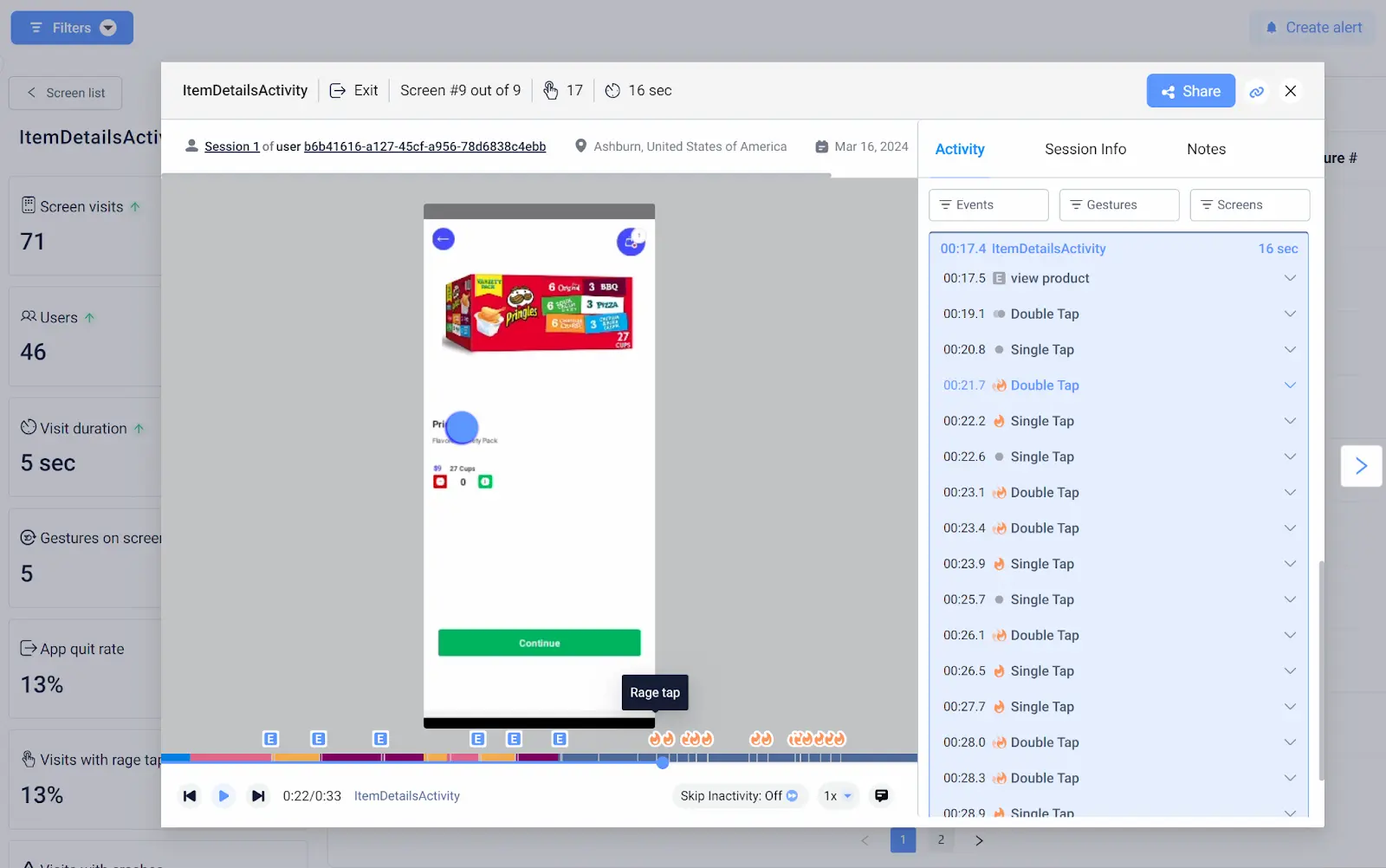
Additionally, heatmaps are instrumental in pinpointing areas with high interaction, revealing potential problem spots that may hinder usability. For instance, a heatmap will show if users are repeatedly tapping on a non-responsive button.

Furthermore, crash reports automatically log any crashes and errors, offering context for each issue encountered. By leveraging these features, you can make informed decisions to improve your user experience and address issues effectively.

Step 2: Manual testing
Manual testing involves physically using the app to identify bugs. For example, you may test a shopping cart feature by adding, removing, and purchasing items. This hands-on approach may be time-consuming but it often offers insights that automated tests miss.
Make sure to consider the following tips when conducting manual testing
Focus on usability: Test different functions to see if they work as intended.
Test on multiple devices: Ensure the app works across various devices and operating systems.
Simulate real-world scenarios: Use the app as a regular user would to uncover hidden bugs.
Step 3: Automated testing
Automated tests can quickly and efficiently run through numerous scenarios, saving time and effort.
Unit tests: Test individual components of the app.
Integration tests: Ensure different components work well together.
UI tests: Automate the user interface interactions to catch visual and functional bugs.
You can use tools like Appium or Espresso for automated testing. These tools simulate user interactions and generate reports for easier debugging.
Step 4: Beta testing
Beta testing involves releasing the app to a small group of users outside your development team. This works similarly to manual testing but with more users. It typically involves the following:
Select diverse testers: Include users with different devices and usage patterns.
Collect feedback: Use surveys or in-app feedback forms to gather opinions.
Monitor behavior: Use UXCam analytics tools to track how beta testers interact with the app.
UXCam can track user interactions across different versions of a feature, making it easier to conduct A/B tests during beta testing. By comparing how users engage with each version, you can determine which design or functionality works better and identify any bugs or issues specific to a particular version.

Step 5: Analyze user feedback
User feedback is a goldmine for identifying bugs. Monitoring app reviews and social media mentions can highlight common issues. For example, if multiple users report a crashing issue on a specific device, prioritize fixing it.
There are four ways to analyze user feedback:
App store reviews: Regularly check for feedback on the Google Play and Apple app stores.
Social media monitoring: Use tools to track mentions of your app on platforms like Twitter and Facebook.
In-app feedback: Enable features that allow users to report bugs directly through the app.
UXCam analytics: Use issue tracking to identify and prioritize bugs experienced by beta testers.
UXCam's Issue Analytics tool offers in-depth insights into technical problems users face, enabling teams to analyze what happened during app failures. By using session replays, teams can see user interactions leading up to incidents like crashes or freezes, providing essential context for troubleshooting.
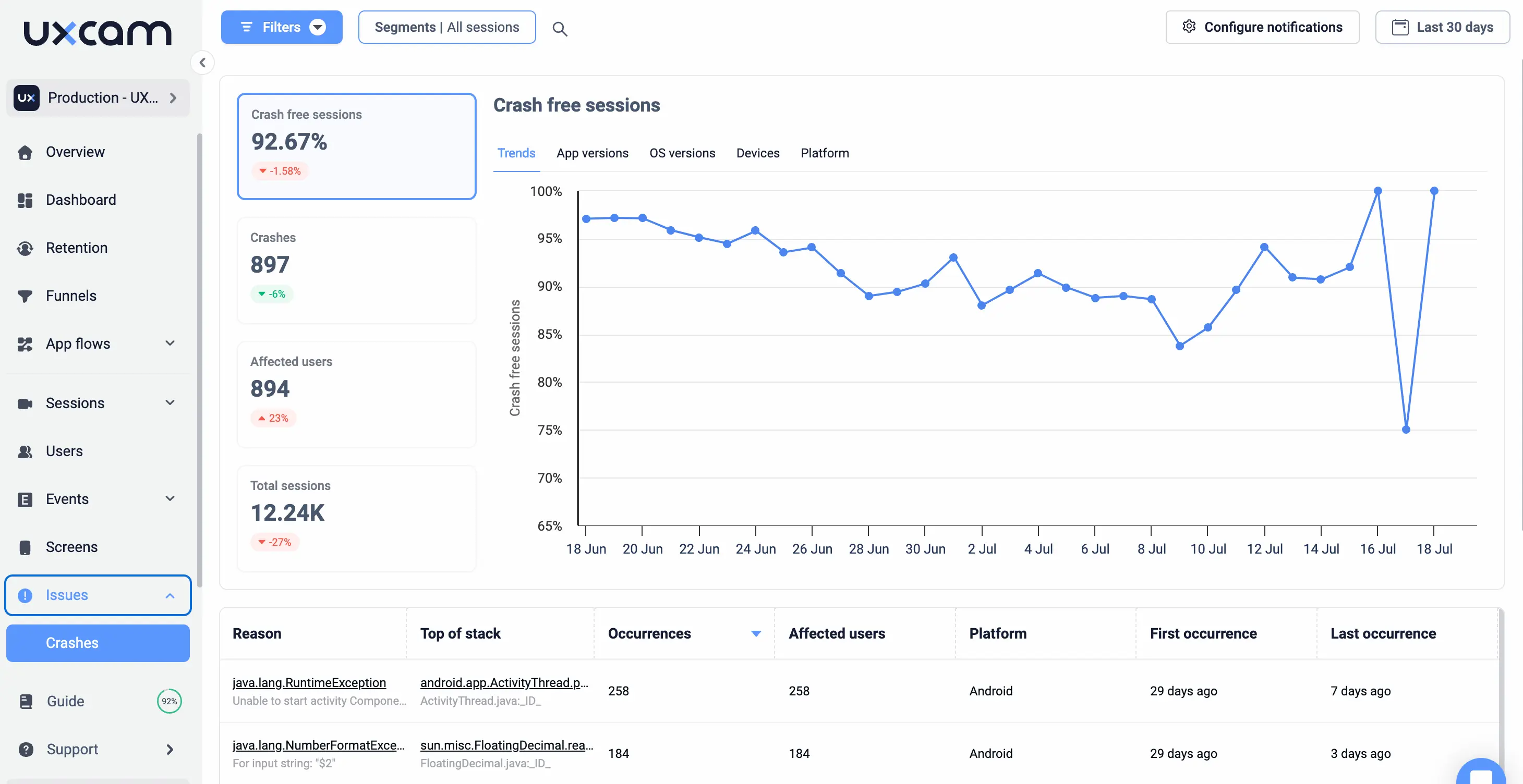
UXCam also features detailed issue logging that monitors different types of issues and compiles statistics regarding their frequency, the number of users impacted, and trends over time. This comprehensive data helps in identifying patterns and root causes, allowing teams to address and resolve issues more effectively.
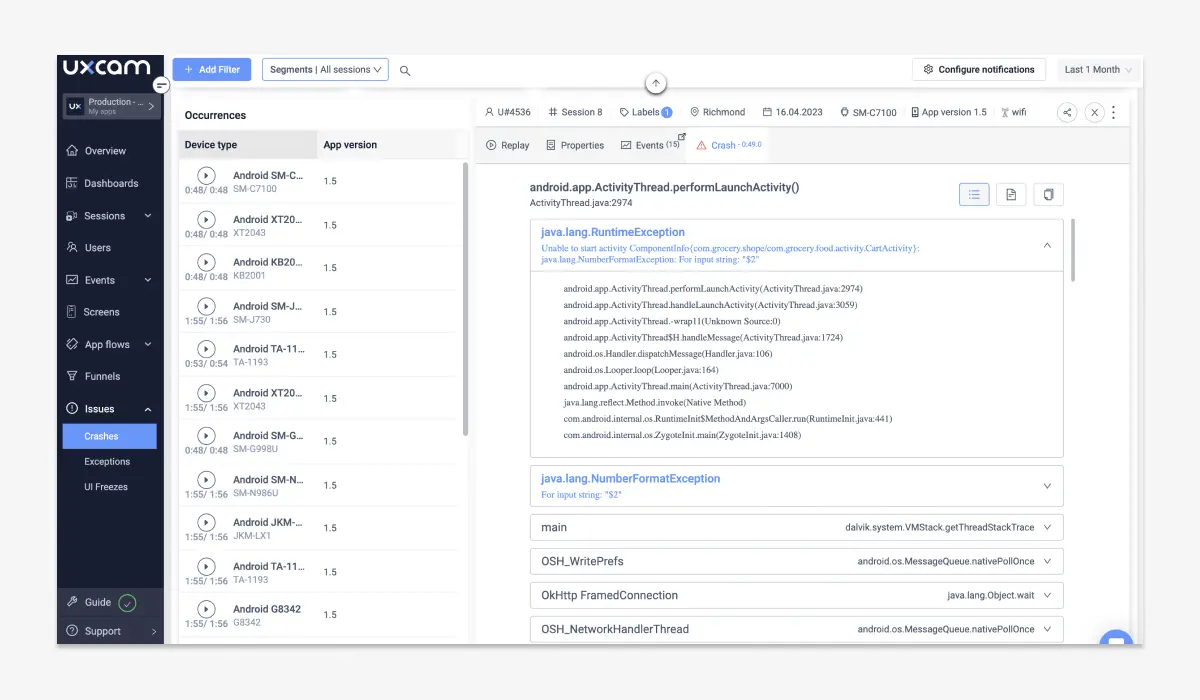
Step 6: Continuous monitoring
Even after the app is launched, continuous monitoring is needed to catch any bugs that might pop up.
UXCam’s Slack integration allows users to receive real-time updates about issues in their shared workspace. This feature aims to keep users informed about both first-time and recurring issues.
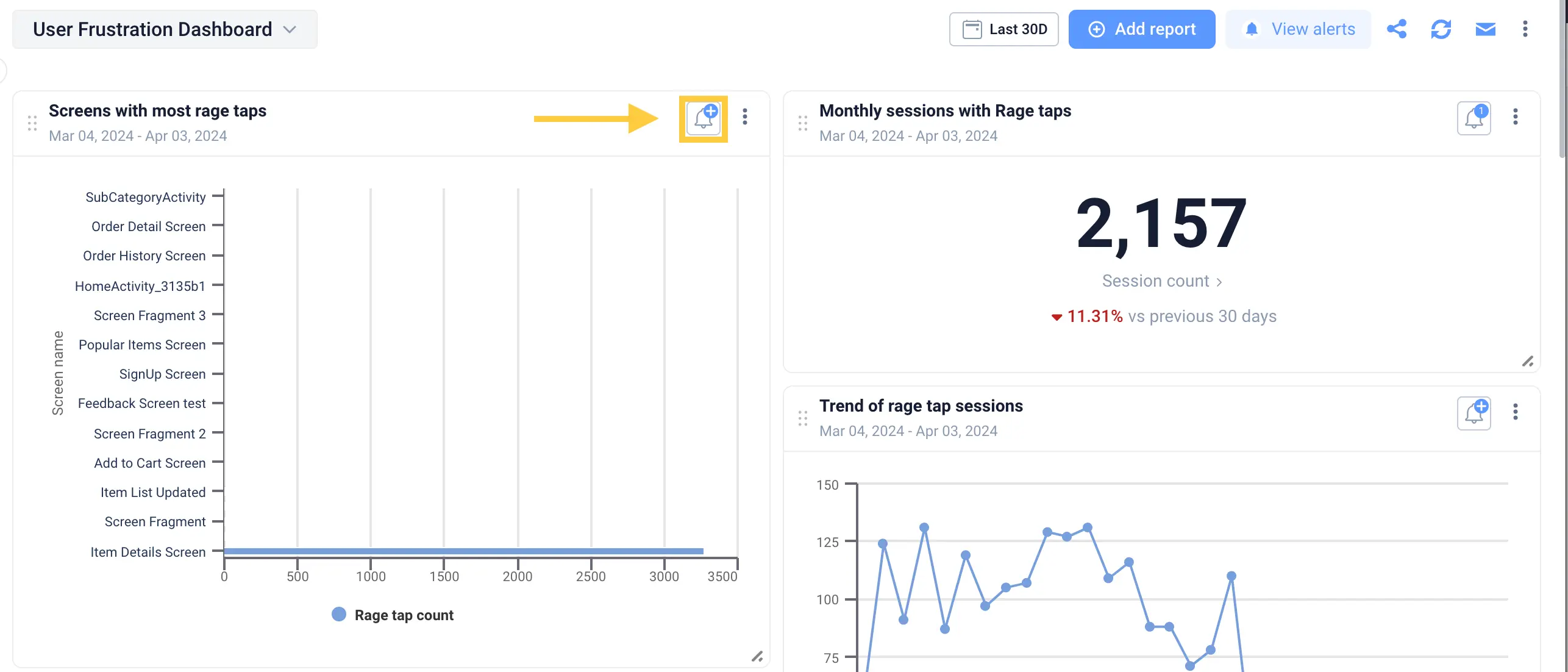
To prevent overwhelming users with excessive notifications, alerts will be strategically sent only when an issue occurs multiple times. This is done at the 10th, 100th, and 1,000th occurrence.
Each notification will include a link that allows users to quickly access session recordings to understand the context of the issues, as well as the option to tag team members who may need to address the situation immediately.
Best practices for finding bugs in apps
Stay organized
It’s important to keep detailed records of identified bugs, including steps to reproduce each issue and their current status. This helps with troubleshooting and improves communication among team members.
Using project management tools like Jira or Trello can effectively organize and prioritize tasks, ensuring that no issues are overlooked. Implementing these strategies enhances your team's efficiency in resolving bugs.
Prioritize bugs
Not all bugs are equal; they need to be prioritized based on their impact on user experience and business goals. Focusing on high-impact bugs first helps to keep user satisfaction high.
Involve the whole team
Bug fixing is a team effort involving developers, testers, and designers to effectively address issues. Collaboration from diverse professionals leads to better solutions.
Regular team meetings improve coordination, align goals, and facilitate communication, streamlining the bug-fixing process and improving product quality. Tools like Slack and Microsoft Teams support real-time discussions and updates.
Conclusion
Finding and fixing bugs in mobile applications is vital for maintaining a seamless user experience. With tools like UXCam, you can quickly and efficiently identify and resolve issues, ensuring your app remains top-notch.
Ready to take your bug-finding skills to the next level? Try UXCam for free and see how it can streamline your debugging process.
You might also be interested in these;
Best Practices for Error Handling in React Applications
The only 10 slides you need to present session replay findings
App Versioning Best Practices - 7 Strategies for Version Tracking
Mobile App Conversion Rate: Benchmarks & Best Practices
Flutter Crashlytics - Integration Guide for Your Mobile Apps
AUTHOR

Tope Longe
Product Analytics Expert
Ardent technophile exploring the world of mobile app product management at UXCam.
What’s UXCam?
Related articles
Curated List
Top 19 Mobile App Analytics Tools in 2026
Discover the top mobile analytics tools in 2026. Compare features, pricing, and reviews to choose the right platform for app tracking, behavioral insights, and data-driven...

Jonas Kurzweg
Product Analytics Expert
App Analytics
Mobile App Tracking: Practical Guide & Best Tools [2026]
The best tracking tools for mobile...

Jonas Kurzweg
Product Analytics Expert
App Analytics
Best Android App Analytics Tools in 2026
Discover the top 8 Android analytics including UXCam, Firebase, and Flurry Analytics. Compare features, pricing, and platforms...

Annemarie Bufe
Product Analytics Expert


